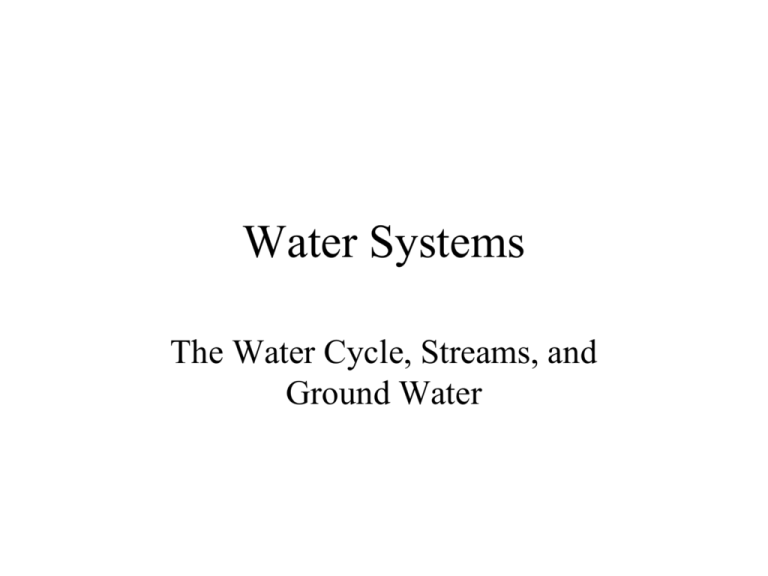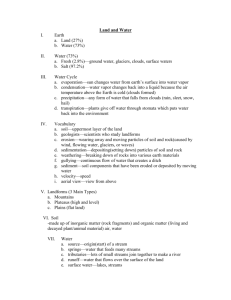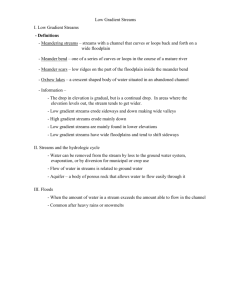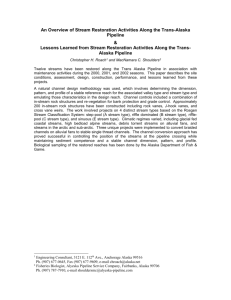River Systems - The Daly Buzz
advertisement

Water Systems The Water Cycle, Streams, and Ground Water Earth’s Water Supply Water Cycle • movement of water between the atmosphere, the land, and the oceans. Evaporation • Water changing from liquid phase to a gaseous phase(water vapor) without boiling. • Surface 2/3 Water • 500,000 km3 /year • Evapotranspiration – evaporation from plant leaves. Condensation • change of state from a gas to a liquid • When water vapor rises in the atmosphere, it expands and cools. • As the vapor becomes cooler; some of it condenses back to liquid • High – Clouds • Low – Fog • Surface - Dew Precipitation • Any form of water that falls to Earth’s surface (rain, snow, sleet, and hail) • Most precipitation falls on Earth’s oceans. • The rest falls on land and becomes runoff or infiltrates the soil to become groundwater. Runoff • Rain that falls to the ground and is not absorbed • Moves along the surface of the land until it flows into a stream system • Causes erosion. Factors Affecting Runoff • Rate of rain Runoff • Slope Runoff • Buildings Runoff • Plants Runoff River Systems • watershed (AKA basin) the area of land that is drained by a river system • The ridges or elevated regions that separate watersheds are called divides. • tributaries streams that flows into a lake or into a larger stream • A river system is made up of a main stream and tributaries. Mississippi River Basin Moosehead Lake Watershed Contains: • 31 lakes • 549 m2 of land •400 miles of rivers and streams •empties out into the Atlantic Ocean River Systems • Channel - Depression that a stream follows as it flows downhill • Banks - The edges of a stream channel that are above water level • Bed - The part of the stream channel that is below the water level • A stream channel gradually becomes wider and deeper as it erodes its banks and bed. River Systems stream load - Sediment carried by a stream • Stream load takes three forms – suspended load – bed load – dissolved load Stream Load River Systems Stream gradient the change in elevation over a given distance • Near the headwaters, or the beginning of a stream, the gradient generally is steep. • As the stream nears its mouth, its gradient often becomes flatter. • The characteristics of streams with different gradients are very different Gradient River Systems • River systems change continuously because of erosion. • Depending on the slope of the land, streams have three stages of development. Young, Mature, and Old • These differing streams support different types of organisms Young Streams • Flow swiftly through a steep valley. • Lots of whitewater and waterfalls because they have not yet eroded all the material in their way. • Young streams erode most on the bottom and less on the sides. Qualities • • • • Fast Moving High oxygen Cold Little Nutrients Stream Merging • Many young streams join together to form larger streams. • Depending on the slope of the land and the amount of water they will form either mature or old streams Mature and Old Streams • Mature and Old Streams flow through floodplains. • floodplain an area along a river that forms from sediments deposited when the river overflows its banks • Occurs when water levels increase depending on the amount of rainfall and snowmelt in the watershed. Floodplains Mature Streams • Curving streams that flow down a gradual slope • Erode more on their sides than on the bottom. • This leads to the creation of meanders (curves in a stream) Qualities • Lots of sediment/nutrients – Erosion from young streams • Slow moving – Algae can grow Evolution of Mature Streams meander • When a river rounds a bend, the velocity of the water on the outside of the curve increases. – Increase erosion • On the inside of the curve, the velocity of the water decreases. – Increased deposition • Causes curves to widen Stream Flow Horseshoe Bend of the Colorado River near Page, AZ Oxbow Lakes • The curve enlarges while further erosion takes place on the opposite bank, where the water is moving more quickly. • Meanders can become so curved that they almost form a loop, separated by only a narrow neck of land • This can eventually become separated into an oxbow lake Old Streams • Old streams flow very slowly through a broad flat floodplain. • Usually they have lost their meanders and flow more straightly. Deltas and Alluvial Fans • Fan-shaped masses of sediment deposited as a stream slows • Deltas occur where streams meet oceans • Alluvial fans result where streams loose energy as the slope decreases rapidly. Groundwater • Water that absorbs into the ground and is located in the spaces between sediments (pores) • These pores are connected and allow water to flow through them. Permeability • Ability of a material(rock/sediment) to allow water to flow through it. • Permeable rock/sediment layers allow water to pass through easily • Impermeable rock/sediment layers resist the flow of water. • Depends on size and shape of sediment Zone of Saturation • Ground water fills the pores in the permeable rock/sediment layer creating an aquifer. • The area of the soil where all of the pores have completely filled with water is referred to as the zone of saturation. • The upper limit of this zone is called the water table. Wells • Holes that are dug below the water table. • Water has been filtered by sediment. • If water table drops (drought) it can dry up the well. • Too many wells in one area can also lower the water table Artesian Wells • Special kind of well where water is pushed up to the surface naturally. • Require a special kind of geography where an aquifer is sandwiched between impermeable layers and the layers change in elevation. • Gravity creates pressure that forces water up artesian wells. Springs • Springs can exist where the groundwater reaches the surface • Some times cracks allow natural artesian wells to form. • Freshwater springs exist along coasts where fresh ground water enters the ocean. Hot Springs and Geysers • Occur where groundwater is stored near hot rocks • Hot springs - near boiling water leaks up to the surface. • Geysers - boiling water and steam is periodically released causing a stream of hot water to shoot out of the ground. Caves and Sinkholes • Form as carbonic acid dissolves limestone. • Caves are structurally stable and do no collapse. • If soil above a cave is weak and it collapses into a sinkhole. • People pumping water out can turn caves into sink holes Stalactites and Stalagmites • Little CO2 in caves, carbonic acid breaks down, can’t hold dissolved limestone. • Limestone accumulates as water drips • Stalactite - ceiling of the cave • Stalagmite - ground of the cave QuickTime™ and a decompressor are needed to see this picture. Adaptations • Animals must have special adaptations to deal with living in a cave • Dark • No plants • Wet • Dangerous Chemicals







